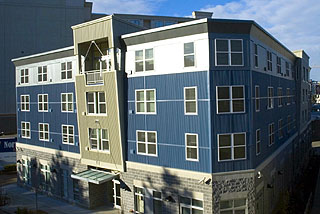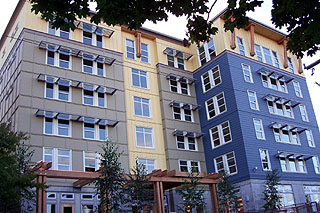
Surveys
DJC.COM
December 7, 2007
Downtown becomes too pricey for disabled homeless
DESC

Hobson
|
Tonight, according to accepted local estimates, 8,500 men, women and children will be living on the streets and in shelters in Seattle and King County. More than 2,500 members of this local homeless population are coping with serious and persistent mental disorders, chronic addictive illnesses, HIV/AIDS, and mobility or sensory impairments. Most will have more than one disabling condition.
This group represents some of the most vulnerable people in our community and, when left on the streets, they represent significant expense to local taxpayers.
The Downtown Emergency Service Center (DESC) serves this population in a variety of housing programs ranging from emergency shelter to permanent housing, and a variety of licensed clinical programs ranging from street outreach/engagement to permanent, on-going clinical care. DESC has done this since 1979. It is one of the largest multi-service organizations serving homeless adults in the Pacific Northwest, working with more than 6,000 people each year, with a staff of 270 and an operational budget of $17 million.
Supportive housing

Photos courtesy of DESC In December 2005, DESC opened 1811 Eastlake, which provides permanent housing for 75 chronic alcoholics. The project was delayed 28 months when a private developer with nearby office buildings tried to stop it in court. |
Ending homelessness for disabled people means building permanent, affordable housing specifically designed to meet their various needs. The model is called supportive housing and includes intensive, on-site, 24-hour support services dedicated to assisting residents achieve and maintain clinical and social stability. It’s permanent as opposed to transitional housing — all residents have leases protected by landlord/tenant, just-cause eviction ordinances. For DESC, the entire housing environment is designed to help residents keep their housing and improve their lives.
Supportive housing means much more than a building with services. The design of the facility, staffing patterns, program values and ways of interacting with residents combine to create a program that helps people succeed over the long term. Our first project was opened in 1994 and today we have six in operation. In all, we operate 650 units of supportive housing and have more than 200 under development.
Unique challenges

DESC in October opened Evans House at 415 10th Ave. on Seattle’s First Hill. The project provides 75 units of permanent housing for those living with mental disorders. |
Half of DESC’s housing stock is located in Seattle’s downtown core and most of the rest is located closely adjacent to that core.
In the past several years, rising land prices and stiff competition from private developers have made development of this type of housing in downtown extremely difficult. When we do find a downtown site within our price range, it is almost always oddly shaped, has environmental or soils issues, or some other feature that renders it unattractive to market-rate developers.
In the past, we have managed these issues by becoming in-fill specialists. Now, unfortunately, even these types of site opportunities are becoming increasingly rare. Consequently, we have begun to look at and develop in other Seattle neighborhoods.
Operating supportive housing is expensive. Normal property management costs make up less than a third of the annual cost of operating one of our projects. The support service package required to responsibly operate our housing significantly increases our operational costs. DESC’s income for each project is controlled by public contracts that provide operating and rent subsidies and are relatively fixed.
In order to generate enough revenue to sustain our support-service costs, we need to develop projects that are at least 75 units. As we move out into more residential, less commercial neighborhoods, that size and public perceptions of our residents present us with additional development challenges.
We are required by public funding sources to notify neighborhoods of our intent to develop there in a scope far beyond the typical Seattle Department of Planning and Development’s noticing. Reactions to that notification vary widely from immediate support from some residents, to cautious questions from others, to outright opposition from still others.
In our experience thus far, the large majority fall into the “cautious questioning” category. Almost without exception, this group is reasonable and fair-minded. Their questions usually focus on safety for their children and themselves, as well as their property values.
These are perfectly valid questions for people to ask when they know little about the dynamics of illness or homelessness. Fortunately, there are good answers to these questions. Ample research, both in Seattle and nationally, shows that property values do not decline nor does the presence of supportive housing for homeless people prevent or retard economic development. And, statistically, disabled homeless people are less assaultive and commit less serious crimes than all the rest of us.
At DESC, we see every day what housing can do — men and women who have been homeless for years regain their health, their dignity and their humanity. People reconnect with parents, children or siblings. They make friends, rediscover interests, find work or other meaningful activity. When these men and women recover their lives, it improves the quality of life for all of us. Our community becomes a better place to live and work.
Unfortunately, most media attention focuses on opponents and the shriller they are, the more attention they get. They tend to demonize homeless people with disabilities and distract the community from focusing on real solutions to end homelessness.
Community-wide solution
Those solutions really exist. There is a plan in our community to end homelessness. That plan was developed by leadership from the business community of Seattle/King County, major faith organizations, the largest philanthropic organizations, local governments and provider organizations such as DESC. They know that during the past 25 years much has been learned about how to successfully serve and house even the sickest and most vulnerable homeless persons. In our community, there are a number of excellent housing and service organizations that are successfully implementing those lessons and are eager to do more of it.
But, there is only so much that can or should be done in downtown Seattle. If we are to successfully house King County’s 2,500 disabled homeless residents, other neighborhoods will be called on to accept such projects in the coming years. No disabled homeless person was born and raised in downtown Seattle. The homes of origin of the large majority are spread throughout the neighborhoods of King County. Isn’t it time they came home?
Bill Hobson is executive director of the Downtown Emergency Service Center. Under his leadership, DESC has received a Best Practice Award from the U.S. Department of Housing and Urban Development, an Exemplary Program Award from the U.S. Department of Health and Human Services, and two MetLife Awards for Excellence in Affordable Housing.
Other Stories:
- Commercial real estate continues its strength
- Retail evolves in mixed-use projects
- Use cost segregation to cut Uncle Sam’s bite
- Too many condos in Seattle? Think again
- An urban village emerges on Seattle’s First Hill
- Pros and cons of the Industrial Jobs Initiative
- What’s next for Seattle’s CBD office market?
- Developing retail? Here are some things to know
- Workforce housing shortage is a ‘silent epidemic’
- Now is the time for apartments — but beware!
- Will good times continue for our market?
- Full speed ahead as CBA turns 30
- CBA Insights speaker profile: Dennis Wilde
- CBA Insights speaker profile: John Parker
- CBA Insights speaker profile: Linda Berman
- Hot Eastside office market won’t get red hot
Copyright ©2009 Seattle Daily Journal and DJC.COM.
Comments? Questions? Contact us.